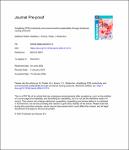Amplifying PCR productivity and environmental sustainability through shortened cycling protocols
| dc.contributor.author | Pedlar, M | |
| dc.contributor.author | Emery, MJ | |
| dc.contributor.author | Warburton, PJ | |
| dc.date.accessioned | 2024-02-01T13:26:32Z | |
| dc.date.available | 2024-02-01T13:26:32Z | |
| dc.date.issued | 2024-01 | |
| dc.identifier.issn | 0300-9084 | |
| dc.identifier.issn | 1638-6183 | |
| dc.identifier.uri | https://pearl.plymouth.ac.uk/handle/10026.1/21992 | |
| dc.description.abstract |
Since its inception in the 1980s, advancements in PCR technology using improved thermal cyclers, engineered DNA polymerases and commercial master mixes, have led to increased PCR productivity. Despite these advancements, PCR cycling protocols have largely remained unchanged over the same period. This study aimed to systemically evaluate the effect of reduced PCR cycling parameters on amplicon production. The 1466bp fragment from the 16S rRNA gene present in low-, medium- and high-CG bacteria was amplified using three commercially available PCR master mixes. The shortest cycling parameters required to successfully amplify the 16S fragment from all bacteria and master mixes comprised 30-cycles of 5 s denaturation, 25 s annealing, and 25 s extension. While all produced an amplicon with sufficient yield to enable downstream sequence analysis, the PCRBIO Ultra Mix in conjunction with the shortened parameters was found to achieve the highest amplicon yield across low-, medium- and high CG bacteria. Comparing the run times to that of a typical 16S PCR protocol, the shortened cycling parameters reduced the program duration by 46 % and consumed 50 % less electricity, translating into increased productivity and helping to improve laboratory environmental sustainability. | |
| dc.format.extent | S0300-9084(24)00031-2- | |
| dc.format.medium | Print-Electronic | |
| dc.language | en | |
| dc.publisher | Elsevier BV | |
| dc.subject | 16S rRNA | |
| dc.subject | Environmental sustainability | |
| dc.subject | PCR | |
| dc.subject | Thermal cycling | |
| dc.title | Amplifying PCR productivity and environmental sustainability through shortened cycling protocols | |
| dc.type | Journal Article | |
| plymouth.author-url | https://www.ncbi.nlm.nih.gov/pubmed/38262587 | |
| plymouth.publication-status | Published | |
| plymouth.journal | Biochimie | |
| dc.identifier.doi | 10.1016/j.biochi.2024.01.013 | |
| plymouth.organisational-group | |Plymouth | |
| plymouth.organisational-group | |Plymouth|Faculty of Health | |
| plymouth.organisational-group | |Plymouth|REF 2021 Researchers by UoA | |
| plymouth.organisational-group | |Plymouth|Users by role | |
| plymouth.organisational-group | |Plymouth|Users by role|Academics | |
| plymouth.organisational-group | |Plymouth|REF 2021 Researchers by UoA|UoA01 Clinical Medicine | |
| plymouth.organisational-group | |Plymouth|Faculty of Health|School of Biomedical Sciences | |
| plymouth.organisational-group | |Plymouth|REF 2028 Researchers by UoA | |
| plymouth.organisational-group | |Plymouth|REF 2028 Researchers by UoA|UoA01 Clinical Medicine | |
| dc.publisher.place | France | |
| dcterms.dateAccepted | 2024-01-19 | |
| dc.date.updated | 2024-02-01T13:26:32Z | |
| dc.rights.embargodate | 2024-02-03 | |
| dc.identifier.eissn | 1638-6183 | |
| rioxxterms.versionofrecord | 10.1016/j.biochi.2024.01.013 |


